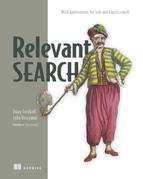Table of Contents
Chapter 1. The search relevance problem
1.1. Your goal: gaining the skills of a relevance engineer
1.2. Why is search relevance so hard?
1.3. Gaining insight from relevance research
1.4. How do you solve relevance?
1.5. More than technology: curation, collaboration, and feedback
Chapter 2. Search—under the hood
2.1.1. What’s a search document?
2.2. Search engine data structures
2.3. Indexing content: extraction, enrichment, analysis, and indexing
2.3.1. Extracting content into documents
2.3.2. Enriching documents to clean, augment, and merge data
2.4. Document search and retrieval
2.4.1. Boolean search: AND/OR/NOT
2.4.2. Boolean queries in Lucene-based search (MUST/MUST_NOT/SHOULD)
2.4.3. Positional and phrase matching
2.4.4. Enabling exploration: filtering, facets, and aggregations
Chapter 3. Debugging your first relevance problem
3.1. Applications to Solr and Elasticsearch: examples in Elasticsearch
3.2. Our most prominent data set: TMDB
3.3. Examples programmed in Python
3.4. Your first search application
3.5.1. Examining the underlying query strategy
3.5.2. Taking apart query parsing
3.5.3. Debugging analysis to solve matching issues
3.6.1. Decomposing the relevance score with Lucene’s explain feature
3.6.2. The vector-space model, the relevance explain, and you
3.6.3. Practical caveats to the vector space model
3.6.4. Scoring matches to measure relevance
3.6.5. Computing weights with TF × IDF
3.6.6. Lies, damned lies, and similarity
4.1. Tokens as document features
4.2. Controlling precision and recall
4.2.1. Precision and recall by example
4.3. Precision and recall—have your cake and eat it too
4.3.1. Scoring strength of a feature in a single field
4.3.2. Scoring beyond TF × IDF: multiple search terms and multiple fields
4.4.1. Dealing with delimiters
4.4.2. Capturing meaning with synonyms
4.4.3. Modeling specificity in search
4.4.4. Modeling specificity with synonyms
4.4.5. Modeling specificity with paths
Chapter 5. Basic multifield search
5.1. Signals and signal modeling
5.2. TMDB—search, the final frontier!
5.3. Signal modeling in field-centric search
5.3.1. Starting out with best_fields
5.3.2. Controlling field preference in search results
5.3.3. Better best_fields with more-precise signals?
5.3.4. Letting losers share the glory: calibrating best_fields
5.3.5. Counting multiple signals using most_fields
5.3.6. Boosting in most_fields
Chapter 6. Term-centric search
6.1. What is term-centric search?
6.2. Why do you need term-centric search?
6.2.1. Hunting for albino elephants
6.2.2. Finding an albino elephant in the Star Trek example
6.3. Performing your first term-centric searches
6.3.1. Working with the term-centric ranking function
6.3.2. Running a term-centric query parser (into the ground)
6.3.3. Understanding field synchronicity
6.3.4. Field synchronicity and signal modeling
6.4. Solving signal discordance in term-centric search
6.5. Combining field-centric and term-centric strategies: having your cake and eating it too
6.5.1. Grouping “like fields” together
6.5.2. Understanding the limits of like fields
6.5.3. Combining greedy naïve search and conservative amplifiers
6.5.4. Term-centric vs. field-centric, and precision vs. recall
Chapter 7. Shaping the relevance function
7.1. What do we mean by score shaping?
7.2. Boosting: shaping by promoting results
7.2.1. Boosting: the final frontier
7.2.2. When boosting—add or multiply? Boolean or function query?
7.2.3. You choose door A: additive boosting with Boolean queries
7.2.4. You choose door B: function queries using math for ranking
7.2.5. Hands-on with function queries: simple multiplicative boosting
7.3. Filtering: shaping by excluding results
7.4. Score-shaping strategies for satisfying business needs
7.4.2. Modeling your boosting signals
7.4.3. Building the ranking function: adding high-value tiers
7.4.4. High-value tier scored with a function query
7.4.6. Capturing general-quality metrics
7.4.7. Achieving users’ recency goals
Chapter 8. Providing relevance feedback
8.1. Relevance feedback at the search box
8.1.1. Providing immediate results with search-as-you-type
8.1.2. Helping users find the best query with search completion
8.1.3. Correcting typos and misspellings with search suggestions
8.2. Relevance feedback while browsing
8.2.1. Building faceted browsing
8.3. Relevance feedback in the search results listing
8.3.1. What information should be presented in listing items?
8.3.2. Relevance feedback through snippets and highlighting
Chapter 9. Designing a relevance-focused search application
9.1. Yowl! The awesome new start-up!
9.2. Gathering information and requirements
9.2.1. Understand users and their information needs
9.3. Designing the search application
9.3.1. Visualize the user’s experience
9.4. Deploying, monitoring, and improving
Chapter 10. The relevance-centered enterprise
10.1. Feedback: the bedrock of the relevance-centered enterprise
10.2. Why user-focused culture before data-driven culture?
10.4. Relevance feedback awakenings: domain experts and expert users
10.5. Relevance feedback maturing: content curation
10.5.1. The role of the content curator
10.5.2. The risk of miscommunication with the content curator
10.6. Relevance streamlined: engineer/curator pairing
10.7. Relevance accelerated: test-driven relevance
10.7.1. Understanding test-driven relevance
10.7.2. Using test-driven relevance with user behavioral data
Chapter 11. Semantic and personalized search
11.1. Personalizing search based on user profiles
11.2. Personalizing search based on user behavior
11.2.1. Introducing collaborative filtering
11.2.2. Basic collaborative filtering using co-occurrence counting
11.2.3. Tying user behavior information back to the search index
11.3. Basic methods for building concept search
11.4. Building concept search using machine learning
11.5. The personalized search—concept search connection
11.6. Recommendation as a generalization of search
Appendix A. Indexing directly from TMDB
A.1. Setting the TMDB key and loading the IPython notebook
Appendix B. Solr reader’s companion
B.1. Chapter 4: taming Solr’s terms
B.1.1. Summary of Solr analysis and mapping features
B.2. Chapters 5 and 6: multifield search in Solr
B.2.1. Summary of query feature mappings
B.2.2. Understanding query differences between Solr and Elasticsearch
B.2.3. Querying Solr: the ergonomics
B.2.4. Term-centric and field-centric search with the edismax query parser
B.3. Chapter 7: shaping Solr’s ranking function
B.3.1. Summary of boosting feature mappings
B.3.2. Solr’s Boolean boosting
B.4. Chapter 8: relevance feedback
B.4.1. Summary of relevance feedback feature mappings
B.4.2. Solr autocomplete: match phrase prefix
